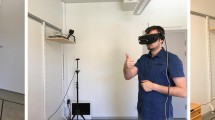Abstract
In recent years, virtual reality technologies have been improving in terms of resolution, convenience and portability, fostering their adoption in real life applications. The Vive Controllers and Leap Motion are two of the most commonly used low-cost input devices for interactions in virtual environments. This paper discusses their differences in terms of interaction design, and presents the results of a user study focusing on manipulation tasks, namely Walking box and blocks, Block tower and Numbered cubes tasks, taking into account both quantitative and qualitative observations. The experimental findings show a general preference for the Vive Controllers, but also highlight that further work is needed to simplify complex tasks.
Access this chapter
Tax calculation will be finalised at checkout
Purchases are for personal use only
Similar content being viewed by others
References
Dias, P., Cardoso, J., Ferreira, B.Q., Ferreira, C., Santos, B.S.: Freehand gesture-based 3D manipulation methods for interaction with large displays. In: International Conference on Distributed, Ambient, and Pervasive Interactions, pp. 145–158. Springer (2017)
Caggianese, G., Gallo, L., Neroni, P.: Evaluation of spatial interaction techniques for virtual heritage applications: a case study of an interactive holographic projection. Future Gener. Comput. Syst. 81, 516–527 (2018)
Dangeti, S., Chen, Y.V., Zheng, C.: Comparing bare-hand-in-air gesture and object-in-hand tangible user interaction for navigation of 3D objects in modeling. In: Proceedings of the TEI 2016: Tenth International Conference on Tangible, Embedded, and Embodied Interaction, pp. 417–421. ACM (2016)
Lin, W., Du, L., Harris-Adamson, C., Barr, A., Rempel, D.: Design of hand gestures for manipulating objects in virtual reality. In: International Conference on Human-Computer Interaction, pp. 584–592. Springer (2017)
Capece, N., Erra, U., Romano, S., Scanniello, G.: Visualising a software system as a city through virtual reality. In: International Conference on Augmented Reality, Virtual Reality and Computer Graphics, pp. 319–327. Springer (2017)
Brancati, N., Caggianese, G., Frucci, M., Gallo, L., Neroni, P.: Touchless target selection techniques for wearable augmented reality systems. In: Intelligent Interactive Multimedia Systems and Services, pp. 1–9. Springer (2015)
Brancati, N., Caggianese, G., Frucci, M., Gallo, L., Neroni, P.: Experiencing touchless interaction with augmented content on wearable head-mounted displays in cultural heritage applications. Pers. Ubiquit. Comput. 21(2), 203–217 (2017)
Gallo, L.: A study on the degrees of freedom in touchless interaction. In: SIGGRAPH Asia 2013 Technical Briefs, p. 28. ACM (2013)
Caggianese, G., Gallo, L., Neroni, P.: An investigation of leap motion based 3D manipulation techniques for use in egocentric viewpoint. In: International Conference on Augmented Reality, Virtual Reality and Computer Graphics, pp. 318–330. Springer (2016)
Piumsomboon, T., Altimira, D., Kim, H., Clark, A., Lee, G., Billinghurst, M.: Grasp-shell vs gesture-speech: a comparison of direct and indirect natural interaction techniques in augmented reality. In: 2014 IEEE International Symposium on Mixed and Augmented Reality (ISMAR), pp. 73–82. IEEE (2014)
Amato, F., Moscato, F.: Pattern-based orchestration and automatic verification of composite cloud services. Comput. Electr. Eng. 56, 842–853 (2016). Cited By 13
Amato, F., Moscato, F.: Exploiting cloud and workflow patterns for the analysis of composite cloud services. Future Gener. Comput. Syst. 67, 255–265 (2017)
Amato, F., Moscato, F.: A model driven approach to data privacy verification in e-health systems. Trans. Data Priv. 8(3), 273–296 (2015)
Gusai, E., Bassano, C., Solari, F., Chessa, M.: Interaction in an immersive collaborative virtual reality environment: a comparison between leap motion and HTC controllers. In: International Conference on Image Analysis and Processing, pp. 290–300. Springer (2017)
Tscharn, R., Schaper, P., Sauerstein, J., Steinke, S., Stiersdorfer, S., Scheller, C., Huynh, H.T.: User experience of 3D map navigation–bare-hand interaction or touchable device? Mensch und Computer 2016-Tagungsband (2016)
Indovina, P., Barone, D., Gallo, L., Chirico, A., De Pietro, G., Antonio, G.: Virtual reality as a distraction intervention to relieve pain and distress during medical procedures: a comprehensive literature review. Clin. J. Pain (2018)
Zhai, S.: Human Performance in Six Degree of Freedom Input Control. University of Toronto (1996)
Boring, S., Jurmu, M., Butz, A.: Scroll, tilt or move it: using mobile phones to continuously control pointers on large public displays. In: Proceedings of the 21st Annual Conference of the Australian Computer-Human Interaction Special Interest Group: Design: Open 24/7, pp. 161–168. ACM (2009)
Bowman, D., Kruijff, E., LaViola Jr., J.J., Poupyrev, I.P.: 3D User Interfaces: Theory and Practice, CourseSmart eTextbook. Addison-Wesley (2004)
Sauro, J., Dumas, J.S.: Comparison of three one-question, post-task usability questionnaires. In: Proceedings of the SIGCHI Conference on Human Factors in Computing Systems, pp. 1599–1608. ACM (2009)
Author information
Authors and Affiliations
Corresponding author
Editor information
Editors and Affiliations
Rights and permissions
Copyright information
© 2019 Springer International Publishing AG, part of Springer Nature
About this paper
Cite this paper
Caggianese, G., Gallo, L., Neroni, P. (2019). The Vive Controllers vs. Leap Motion for Interactions in Virtual Environments: A Comparative Evaluation. In: De Pietro, G., Gallo, L., Howlett, R., Jain, L., Vlacic, L. (eds) Intelligent Interactive Multimedia Systems and Services. KES-IIMSS-18 2018. Smart Innovation, Systems and Technologies, vol 98. Springer, Cham. https://doi.org/10.1007/978-3-319-92231-7_3
Download citation
DOI: https://doi.org/10.1007/978-3-319-92231-7_3
Published:
Publisher Name: Springer, Cham
Print ISBN: 978-3-319-92230-0
Online ISBN: 978-3-319-92231-7
eBook Packages: Intelligent Technologies and RoboticsIntelligent Technologies and Robotics (R0)




